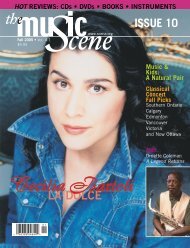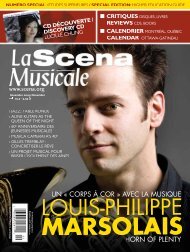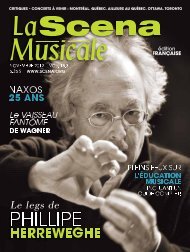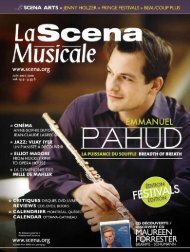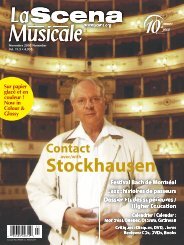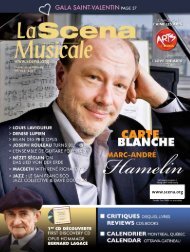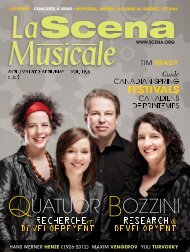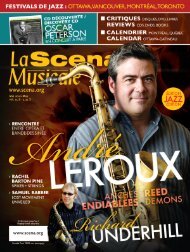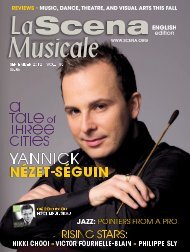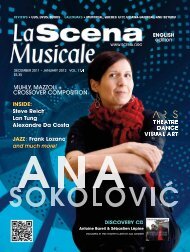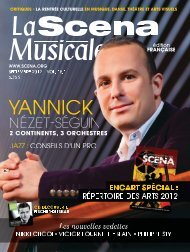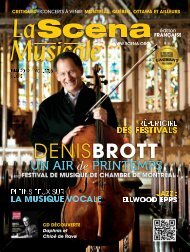The Bohlen-Pierce system - La Scena Musicale
The Bohlen-Pierce system - La Scena Musicale
The Bohlen-Pierce system - La Scena Musicale
Create successful ePaper yourself
Turn your PDF publications into a flip-book with our unique Google optimized e-Paper software.
VIOLIN<br />
True or False?<br />
A “false string” is one that doesn’t<br />
produce the intended pitch correctly<br />
when brand new. Gut strings may ring false brand<br />
new more often than synthetic; however, all strings can<br />
become false with use. Many violinists use the term to<br />
describe any string that doesn’t sound right; the life of<br />
a string is dependent on its construction, frequency of<br />
use, and even sweat. Some players replace their strings<br />
every few weeks while others play happily for a year or<br />
more on the same set.<br />
Muted Moments<br />
Placed on the bridge of the instrument to limit vibrations, mutes<br />
can be made of metal, rubber, leather, and/or wood. Experimenting<br />
with different mutes proves interesting where extensive use of<br />
the mute is mandated, like in Prokofiev’s first violin sonata. Some<br />
musicians prefer the warm resonance of a leather mute, while others<br />
enjoy the metal-and-rubber Heifetz mute. And let’s not forget<br />
the overbearing practice mute, perfect for hotel stays!<br />
Did You Know?<br />
Derived from pine-tree sap, rosin is rubbed on bow hair to better grip the strings<br />
and make them speak. When choosing the<br />
right rosin for your instrument, you have to<br />
take climate into account. Lighter-coloured<br />
rosin is better in humid climates, while<br />
darker rosin is better for dry. If you travel, it<br />
may be wise to carry a few options.<br />
Carissa Klopoushak’s<br />
VIOLIN TIPS<br />
FOR THE BEGINNER<br />
What would you consider to be an important, yet often overlooked<br />
element of instrument care that violinists should<br />
follow in order to maintain their instrument?<br />
It’s important to get into good habits for storing your instrument<br />
early on. Remember to loosen your bow, wipe the rosin from your<br />
violin, and place your violin in a case, closed, with special attention<br />
to the temperature and humidity. Avoid DIY repair jobs; seek professional<br />
help, whenever necessary!<br />
FOR THE INTERMEDIATE<br />
LSM What is an essential daily routine that an intermediatelevel<br />
violinist should have in their arsenal to maintain and<br />
further develop their playing?<br />
Stretching and properly warming up are paramount. Habits established<br />
at this stage are more easily carried into the future. Scales<br />
and studies, used wisely, decrease the time needed to learn new<br />
material—a lifesaver. Once you’ve got a handle on traditional methods<br />
(Flesch, Sevcik, etc.), try jazz/modal scales or Terje Moe<br />
Hansen’s method.<br />
FOR THE ADVANCED<br />
LSM What would you recommend as a potentially inexpensive<br />
way to upgrade a violin for someone who may not be able to<br />
afford a professional instrument?<br />
As Pemi Paull suggested in the February issue of LSM, seeing a<br />
trusted luthier regularly is important. Strings and bow hair need<br />
regular replacement, and the occasional sound post adjustment<br />
(extensive experimentation can lead to an ideal placement) goes a<br />
long way. Changing tailpieces, tail gut, chinrests, bridges, and<br />
shoulder rests can help make meaningful changes to the sound and<br />
projection of your instrument. However, it’s important not to over<br />
think our equipment choices; often the equipment is not to blame!<br />
LSM If you could recommend one work and recording that<br />
would romance anyone into falling in love with the violin,<br />
what would it be and why?<br />
<strong>The</strong> G major Sonata by Johannes Brahms. It’s perhaps the most<br />
lyrical composition among all of Brahms’s instrumental works. It<br />
takes you on an emotional journey through bliss and sorrow, longing<br />
and rapture. <strong>The</strong>re are many wonderful recordings,<br />
but one of my favourites is Joseph Suk and<br />
Julius Katchen. [Brahms: <strong>The</strong> Violin Sonatas;<br />
Joseph Suk, violin; Julius Katchen, piano; Decca:<br />
Legendary Legends (1967)]<br />
Winner of the 2009 Eckhardt-Grammatté Competition,<br />
Carissa is highly sought after as a recitalist and chamber<br />
musician. She performs with such ensembles as<br />
Mooncrest, Portmantô, Boundary,<br />
the National Arts Centre<br />
Orchestra, and is a director of<br />
the Ritornello Chamber Music<br />
Festival in Saskatoon. Carissa is<br />
completing a Doctorate in Violin<br />
Performance at McGill University<br />
with Jonathan Crow.<br />
www.carissaklopoushak.com,<br />
www.ritornello.ca,<br />
www.tytitam.com<br />
PHOTO Matt Smith<br />
APRIL 2012 13



